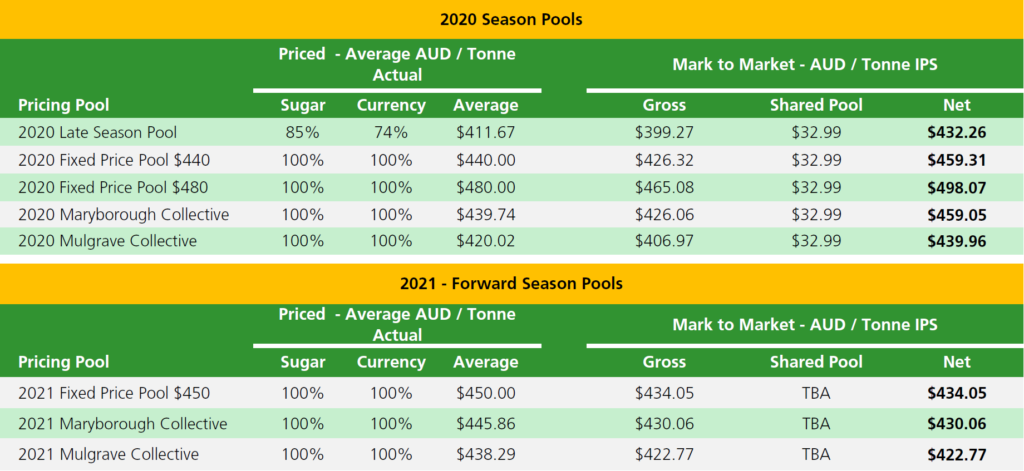
2021 Forward Pricing & Pool Update
MSF filled 2021 grower individual forward pricing orders at $450 and slightly better on several occasions through the months of February and March. The 2021 price has since retreated to currently be hovering around $430 per metric tonne actual.
On top of the good results achieved by individual growers the Mulgrave and Maryborough Collective Pools have again recorded strong results for the coming season. Both of these pools have recently completed pricing for 2021 achieving $438 and $446 per metric tonne actual respectively. All pool values can be viewed below:

Major Headlines
- It’s hard to believe that in late February the spot value of sugar hit 18.94 cents per pound. The last five weeks have seen an orderly retreat from that level to today’s 14.77 c/lb.
- The sugar market has been devoid of fresh fundamental news for the past number of weeks which has sapped the bullishness from speculators who have been steadily unwinding their long positions which has pushed prices lower triggering further speculator selling – a vicious cycle.
- On top of a lack of fundamental news specific to the sugar market, prices have also suffered at the hands of the so called “third wave” of coronavirus lashing Europe and the US. Combined with this is a much slower than anticipated rollout of vaccines globally which has dented the confidence of investors. Most commodities have seen their value drop over the past month as a consequence of this macroeconomic uncertainty, sugar has been one of the worst performers.
- Thailand has all but finished it’s season with only 2 mills left crushing as of the 29th of March. The crop will finish at close to 66.67 million tonnes of cane at 12.91 average CCS. Estimates for Thailand’s next crop commencing November 2021 range from 70-100 million tonnes of cane.
- Brazil’s centre-south region should produce between 35.5 million and 35.8 million metric tonnes of sugar this season commencing April 1, according to analysts. These are big numbers although hardly surprising given sugar’s superior value compared to ethanol.
- Brazil’s sugar mix (percentage of cane used to manufacture sugar rather than ethanol) is forecast at 45.2%, compared to 45.5% in the 2020/21 season. One of the reasons we don’t believe there is going to be much of a change in terms of the sugar split is price. According to analysts the centre-south has already priced 70% of its total forecast 2021 sugar exports at an average price of BRL1,500/t. These are very good prices relative to previous years, the cost of production for the better Brazilian millers is estimated at BRL1,000/t or less.
- Logistical issues loom as a major challenge for Brazil as multiple crops compete for limited export space at key ports. We saw sugar ships waiting up to 30 days to load sugar at Santos port last year, the expectation is that wait times will be longer this year as a very large and very late soybean crop commences it’s journey from Brazil to China at the same time that sugar starts moving to port. Traditionally soybeans would be harvested and moved early in the new year however weather delayed planting last year.
- Oil Prices: as mentioned earlier oil prices have suffered recently as covid continues to take a toll on markets globally. Given the softer than expected demand and continued uncertainty it seems highly unlikely that OPEC+ will move to increase oil production anytime soon.
- The Australian Dollar briefly traded above 0.80 with the USD in late February. Being a commodity currency the AUD has since retreated in line with commodities, currently trading around 0.7598.
- Where to from here? Failing any fresh positive fundamental news impacting the sugar market it seems sugar will continue to take influence from macroeconomic factors. An improvement in covid infection rates and/or vaccine roll out is likely to restore investor confidence that a post covid global economic boom is on the horizon. This would see a bounce in commodity prices across the board particularly oil which would benefit from increased travel, trade and general economic activity. This sort of confidence would likely spill over into the sugar market (and the AUD).
